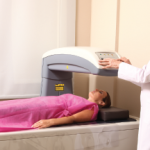Bone microarchitecture is impaired in premenopausal women with active celiac disease, a new study from Argentina shows.
“This report helps us to understand how bone is affected in celiac disease: increasing bone resorption and thinning trabeculae, even losing some number of them,” Dr. María Belén Zanchetta from Instituto de Diagnóstico e Investigaciones Metabólicas in Buenos Aires told Reuters Health by email. “We do not know yet if this damage can be completely reversed with gluten-free diet.”
Osteopenia and osteoporosis are recognized complications of celiac disease, but no studies have assessed the microarchitectural quality of bones in celiac disease patients. Dr. Zanchetta’s team used high-resolution peripheral quantitative computed tomography (HR-pQCT) to compare microarchitectural characteristics of peripheral bone in 31 adult premenopausal women with active celiac disease and 22 healthy premenopausal women of similar age and body mass index (BMI).
Compared with controls, women with celiac disease had 26.4% lower trabecular density, 18% lower trabecular thickness, and 10.5% lower trabecular number in the distal radius, along with 15% higher trabecular spacing and 23% higher heterogeneity of the trabecular network (all statistically significant). Results were similar at the distal tibia, the researchers report in Bone, online March 14.
Microarchitectural deficits were more substantial among women with symptomatic celiac disease than among those with subclinical celiac disease. Bone mineral density (BMD) z-scores were significantly lower at lumbar spine, femoral neck, and distal radius among women with celiac disease than among healthy controls, although the mean scores were within the normal range. Seven patients had serum calcium concentrations below the lower end of the reference range, nine patients had elevated C-telopeptide concentrations, and only three patients had serum vitamin D levels above 30 ng/mL. HR-pQCT results correlated significantly with age, BMI, C-telopeptide concentrations and vitamin D levels.
“In the prospective follow-up of this group we hope to be able to assess if bone microarchitecture can be restored to normal after gluten free diet,” Dr. Zanchetta said. “In the meantime, we would recommend to assess and prescribe adequate calcium (diet or pills) and vitamin D supplementation in celiac disease patients, apart from exercise and smoking avoidance.”
Dr. William Dickey from Altnagelvin Hospital in Londonderry, Northern Ireland, who has published extensively on celiac disease, said the new work “reinforces that bone health is significantly impaired in premenopausal women with celiac, and the importance of assessing wrist as well as spine and femur density.”
“It remains to be shown whether HR-pQCT is superior to DXA as a clinical tool for the prediction of increased fracture risk,” he told Reuters Health by email. “This is important, as DXA is much more widely available and probably cheaper with lower radiation exposure.”


